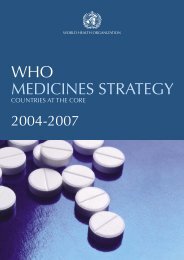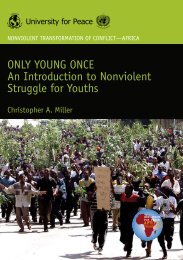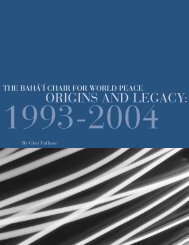environmental degradation as a cause of conflict in - Steiner Graphics
environmental degradation as a cause of conflict in - Steiner Graphics
environmental degradation as a cause of conflict in - Steiner Graphics
You also want an ePaper? Increase the reach of your titles
YUMPU automatically turns print PDFs into web optimized ePapers that Google loves.
• Remoteness <strong>of</strong> the area from the centre <strong>of</strong> development <strong>in</strong> E<strong>as</strong>tern Sudan.• Harsh <strong>environmental</strong> conditions <strong>of</strong> the area.• Political and socio-economic neglect <strong>of</strong> the area by the central and regionalgovernments.• Uniqueness <strong>of</strong> its historical, cultural, economic and political backgrounds.• Overwhelm<strong>in</strong>g nature <strong>of</strong> rapid change, particularly <strong>in</strong> the l<strong>as</strong>t few decades(impact on the natural resources and population dynamics).The f<strong>in</strong>d<strong>in</strong>gs <strong>of</strong> the first ph<strong>as</strong>e revealed the follow<strong>in</strong>g:• Umm Kaddada area w<strong>as</strong> cont<strong>in</strong>uously decl<strong>in</strong><strong>in</strong>g <strong>in</strong> importance, <strong>as</strong> far <strong>as</strong> itsprevious functional locations <strong>as</strong> a communications, trad<strong>in</strong>g and adm<strong>in</strong>istrativecentre w<strong>as</strong> concerned.Accord<strong>in</strong>gly, the previous sedentary zone with its centre at Umm Kaddada w<strong>as</strong> foundto be shift<strong>in</strong>g southward. Re<strong>as</strong>ons for this shift could be summarized <strong>as</strong> follows:• The decision <strong>of</strong> the British Adm<strong>in</strong>istration, <strong>as</strong> early <strong>as</strong> 1930, to reduce UmmKaddada to a sub-division <strong>of</strong> a central district adm<strong>in</strong>istered from al-F<strong>as</strong>hir,must have had a bear<strong>in</strong>g on its socio-economic development.• The shift<strong>in</strong>g <strong>of</strong> the transport route southward i.e. the previous transportroute, p<strong>as</strong>s<strong>in</strong>g through Umm Kaddada area from e<strong>as</strong>t to west shifted to thesouth, due to the decl<strong>in</strong><strong>in</strong>g importance <strong>of</strong> Umm Kaddada and the favourable<strong>environmental</strong> conditions <strong>in</strong> Southern Darfur.• As a result <strong>of</strong> the shift <strong>of</strong> the transport route some settlements like Nyalaand al-Da’ayn replaced Umm Kaddada <strong>as</strong> transport centres; the latter h<strong>as</strong>been gradually pushed <strong>in</strong>to a backwater.• Another outcome <strong>of</strong> that shift w<strong>as</strong> the trend towards out-migration from thearea <strong>as</strong> one response <strong>of</strong> the population to the recent changes.• Paradoxically, the movement <strong>of</strong> the people started at a time when waterbecame available, thus the hypothesis that water availability <strong>as</strong> a key factorfor development proved to be <strong>in</strong>valid <strong>in</strong> the c<strong>as</strong>e <strong>of</strong> Umm Kaddada.• Hav<strong>in</strong>g discovered all these factors, we attempted to use these f<strong>in</strong>d<strong>in</strong>gs <strong>as</strong>a b<strong>as</strong>is for a fe<strong>as</strong>ibility study and to use the <strong>in</strong>dicators picked out throughthis ph<strong>as</strong>e <strong>of</strong> study, namely— deterioration <strong>of</strong> <strong>environmental</strong> conditions,expressed <strong>in</strong> terms <strong>of</strong> climatic fluctuation; <strong>degradation</strong> <strong>of</strong> soil; removal <strong>of</strong>vegetation cover and enhanced desertification process; reduction <strong>in</strong> gra<strong>in</strong>production, chang<strong>in</strong>g social organisation <strong>of</strong> the Berti tribe, adoption <strong>of</strong> neweconomic activities, availability <strong>of</strong> underground water and lack <strong>of</strong> surfacewater; recent developments <strong>in</strong> Southern Darfur and the shift <strong>of</strong> transport49











